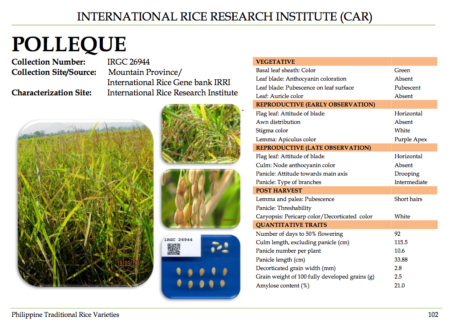- SeedUSoon: A New Software Program to Improve Seed Stock Management and Plant Line Exchanges between Research Laboratories. Great name.
- Building a Global System for the conservation and use of all plant diversity. Botanical gardens learning from crop genebanks?
- Understanding potato with the help of genomics. Crop genebank learning from genomics.
- What are the socioeconomic implications of the value chain of biodiversity products? A case study in Northeastern Brazil. Two Amazonian fruits, very different markets.
- Weak Genetic Structure in Northern African Dromedary Camels Reflects Their Unique Evolutionary History. Severe bottlenecks and long-distance movement makes for quite a genetic mess.
- Genetic variation for tuber mineral concentrations in accessions of the Commonwealth Potato Collection. Is considerable, and might be useful in breeding. I’m shocked.
- The Domestic Livestock Resources of Turkey: Social Aspects, Genetic Resources and Conservation of Companion Animal Cats (Felis Catus). The nondescript cats are not in danger.
- Feasting, Social Complexity, and the Emergence of the Early Neolithic of Upper Mesopotamia: A View from Göbekli Tepe. Agriculture as a result of religious feasting. No word on the role of cats.
- Economic Development and Forest Cover: Evidence from Satellite Data. More money = more deforestation.
Filipino rice landraces documented
Congratulations to all concerned for the launch of the catalogue of Philippine Traditional Rice Varieties. I’m reliably informed it will be available online soon. In the meantime, I’ve had the privilege of consulting a PDF, and I can confirm that it is really as cool as it sounds.

Nibbles: Trees on farms, Biodiversity hotspots, Coconuts, Banana genebank, Fiddleheads, Hybrid wheat, Buckler prize, ITPGRFA hatchet job
- Trees are good for African farmers.
- A basic universal income for people in biodiversity hotspots. Agrobiodiversity hotspots too?
- Coconut History 101.
- 30 years of bananas in Belgium.
- Eat up all your fiddleheads.
- Hybrid wheat is coming at last.
- Ed Buckler wins big. Unclear if he’ll be allowed to tweet about it.
- Nonsense piece on the ITPGRFA.
Brainfood: Wild peanuts, Salt-tolerance, Melon diversity, Consumption & biodiversity, German veggie fanciers, Oh oh oomycetes, Miscanthus diversity, Urban pollinators, Milpa bees
- Genomic characterisation of Arachis porphyrocalyx (Valls & C.E. Simpson, 2005) (Leguminosae): multiple origin of Arachis species with x=9. At least two distinct origins for the x=9 species.
- Salt Tolerant Varieties: A Biological Intervention to Manage Saline and Sodic Environment and Sustain Livelihoods. Salt-tolerant rice and wheat varieties are being adopted where needed in this bit of Haryana, but not as much as they could be.
- Genotyping-by-sequencing of a melon (Cucumis melo L.) germplasm collection from a secondary center of diversity highlights patterns of genetic variation and genomic features of different gene pools. Three subgroups, and that’s just in Puglia, the heel bit of Italy.
- Quantifying biodiversity losses due to human consumption: a global-scale footprint analysis. Food consumption is the single greatest driver of biodiversity loss, somewhere else.
- Old vegetable varieties: attitude, consumption behaviour and knowledge of German consumers. There’s a consumer segment in Germany that could be labelled “fanciers of old vegetable varieties,” apparently.
- Emerging oomycete threats to plants and animals. Be afraid.
- Ecological characteristics and in situ genetic associations for yield-component traits of wild Miscanthus from eastern Russia. Arctic sugarcane? It could happen.
- The city as a refuge for insect pollinators. It could happen.
- Sweat bees on hot chillies: provision of pollination services by native bees in traditional slash-and-burn agriculture in the Yucatán Peninsula of tropical Mexico. The milpa is pretty good refuge for bees already.
Brainfood: CO2 & domestication, Amaranth double, Nordic apple double, Chinese alfalfa, Sheep double, Moroccan lentils, SE Asian veggies, Cattle relative
- Yield responses of wild C3 and C4 crop progenitors to subambient CO2: a test for the role of CO2 limitation in the origin of agriculture. It was tough for CWR in the last glacial period, better afterwards.
- Analysis of phylogenetic relationships and genome size evolution of the Amaranthus genus using GBS indicates the ancestors of an ancient crop. Three cultivated species derived from one wild relative in different geographic regions.
- Genomic and phenotypic evidence for an incomplete domestication of South American grain amaranth (Amaranthus caudatus). Maybe because of continued geneflow with the CWR.
- Unravelling genetic diversity and cultivar parentage in the Danish apple gene bank collection. Only 10% duplicates among 448 accessions, many unique.
- Redundancies and Genetic Structure among ex situ Apple Collections in Norway Examined with Microsatellite Markers. 14 synonyms among 181 accessions. No word on the overlap between Danish and Norwegian collections.
- The Current Status, Problems, and Prospects of Alfalfa (Medicago sativa L.) Breeding in China. 77 registered cultivars for the whole of China seems very few.
- Assessment of genetic diversity and structure of major sheep breeds from Pakistan. They cluster based on use rather than geographic origin.
- Mapping molecular diversity of indigenous goat genetic resources of Asia. Chinese goats are different.
- On-farm Conservation of Zaer Lentil Landrace in Context of Climate Change and Improved Varieties Competition. People like everything about the landrace except its yield.
- Conservation of Indigenous Vegetables from a Hotspot in Tropical Asia: What Did We Learn from Vavilov? Not much, it seems.
- Assessment of genetic diversity of Mithun (Bos frontalis) population in Bhutan using microsatellite DNA markers. Also known as gayal.